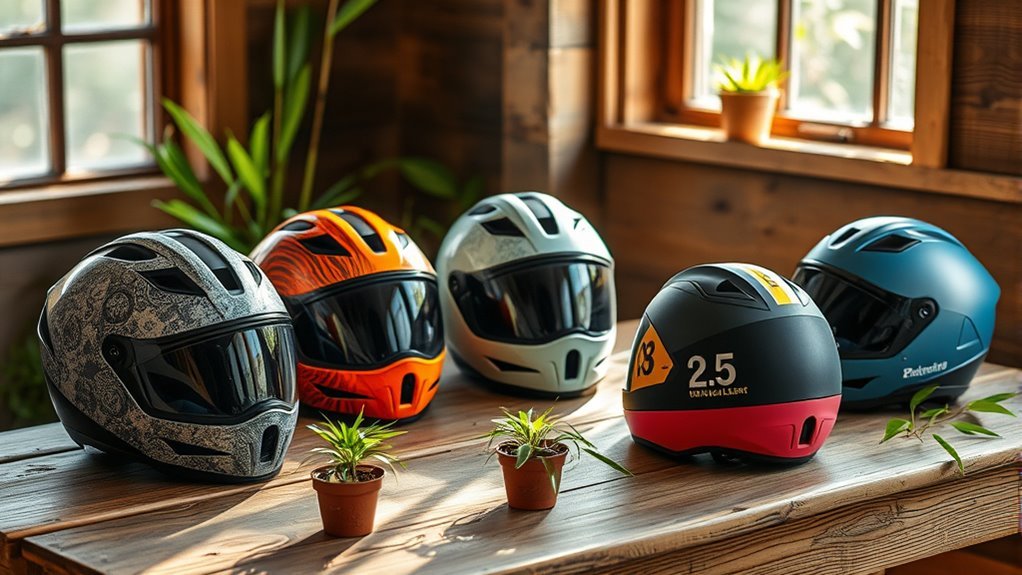Eco-Friendly Helmets: Materials and Brands to Know
When choosing an eco-friendly helmet, you’ll find materials like recycled plastics, biodegradable options, and natural fibers that protect your head while benefiting the environment. Brands are increasingly using sustainable materials, such as hemp and bamboo, along with certifications like CPSC and Snell to guarantee safety. Look for helmets with good ventilation and comfort features for an enhanced riding experience. There’s so much more to discover about the top brands making strides in eco-conscious design.
Understanding Eco-Friendly Helmet Materials

As you explore the world of eco-friendly helmets, it’s essential to understand the materials that make them sustainable. Helmet sustainability hinges on innovative choices like recycled plastics, natural fibers, and plant-based foams. These eco-friendly innovations not only reduce waste but also lessen the environmental impact of production. For instance, some brands have started using hemp and bamboo, which are renewable and biodegradable. Additionally, look for helmets that incorporate water-based adhesives and non-toxic finishes, ensuring a safer product for both you and the planet. By choosing helmets crafted from sustainable materials, you’re not just protecting your head; you’re embracing a lifestyle that values our environment and promotes freedom through conscious consumerism. So, gear up responsibly and enjoy the ride!
Biodegradable Plastics: A Sustainable Choice

While many traditional plastics contribute to environmental degradation, biodegradable plastics present a promising alternative for eco-friendly helmets. These biodegradable options break down over time, reducing landfill waste and pollution. Choosing helmets made from such materials not only supports sustainable manufacturing but also embraces a greener lifestyle. Here are four key benefits of biodegradable plastics in helmets:
Biodegradable plastics offer a sustainable solution for helmets, reducing waste and promoting a healthier environment.
- Reduced Environmental Impact: Breaks down naturally, minimizing pollution.
- Renewable Resources: Often derived from plant-based materials, unlike petroleum-based plastics.
- Safety: Generally free from harmful chemicals, contributing to a healthier environment.
- Market Growth: Increasing availability as brands innovate towards sustainability.
Recycled Fibers: Reducing Waste in Helmet Production

Incorporating recycled fibers in helmet production not only addresses the growing waste crisis but also enhances the performance of the helmets themselves. By utilizing materials that would otherwise end up in landfills, manufacturers contribute to waste reduction while creating safer, lighter, and more durable helmets. These recycled fibers often undergo rigorous testing, ensuring they meet safety standards without compromising quality. Additionally, choosing helmets made from recycled materials aligns with a lifestyle that values sustainability and personal freedom. You’re not just protecting your head; you’re making a statement about your commitment to the environment. As the demand for eco-friendly options rises, helmets crafted from recycled fibers are becoming an essential choice for those who care about both safety and the planet.
Natural Materials: The Benefits of Organic Options
When you choose helmets made from natural materials, you’re not only opting for safety but also embracing a lifestyle rooted in sustainability. These organic options offer a range of health benefits, making them a smart choice for environmentally conscious riders. Here are some key advantages of natural alternatives:
- Biodegradability: Unlike synthetic materials, natural fibers break down over time, minimizing landfill waste.
- Non-toxic: Many organic materials are free from harmful chemicals, providing a safer option for your health.
- Comfort: Natural materials often offer better breathability, enhancing your overall riding experience.
- Durability: High-quality organic materials can compete with synthetic ones regarding strength and longevity.
Top Brands Leading the Eco-Friendly Helmet Movement
As the demand for sustainable products grows, several brands are stepping up to lead the eco-friendly helmet movement, combining safety with environmental responsibility. Brands like Thousand and Nutcase are at the forefront, showcasing sustainable innovation through eco-conscious materials and production processes. They prioritize brand transparency, allowing you to know exactly what goes into each helmet. Additionally, companies like Giro are making strides with recycled components, proving that protecting your head doesn’t have to come at the expense of the planet. When you choose these brands, you’re not just investing in safety; you’re supporting a movement that values our Earth. So, gear up with a helmet that aligns with your values and lets you ride free, knowing you’re making a difference.
Certifications and Standards for Eco-Friendly Helmets
Choosing an eco-friendly helmet means not just considering the brand but also understanding the certifications and standards that guarantee safety and sustainability. You’ll want to look for helmets that meet or exceed established safety regulations set by recognized certification agencies. Here are some key standards to keep in mind:
Selecting an eco-friendly helmet involves understanding key safety certifications to ensure both protection and sustainability.
- CPSC – The Consumer Product Safety Commission sets mandatory safety standards for bike helmets.
- Snell Memorial Foundation – Offers a rigorous certification for high-performance helmets.
- EN 1078 – A European standard for safety in cycling, skateboarding, and roller skating helmets.
- ASTM – The American Society for Testing and Materials provides guidelines for various helmet types.
These certifications confirm your eco-friendly helmet not only protects you but also aligns with sustainable practices.
How to Choose the Right Eco-Friendly Helmet for You
When choosing an eco-friendly helmet, you’ll want to start by evaluating the materials used in its construction, as they can greatly impact both safety and sustainability. It’s also essential to assess safety standards to guarantee you’re getting the protection you need. Finally, don’t overlook the importance of fit and comfort—after all, a helmet that doesn’t feel right will likely end up gathering dust.
Assessing Material Composition
While the market is flooded with helmet options, understanding the material composition of eco-friendly helmets is essential for making an informed choice. By considering several factors, you can align your helmet choice with your values and lifestyle. Here are four key aspects to evaluate:
- Biodegradable Materials: Look for helmets made from plant-based plastics or natural fibers.
- Recycled Content: Opt for products that incorporate recycled materials, reducing the need for new resources.
- Non-Toxic Adhesives: Confirm the glues used are free from harmful chemicals, minimizing environmental impact.
- Sustainable Sourcing: Research brands committed to ethical material sourcing, guaranteeing minimal ecological footprint.
Evaluating Safety Standards
As you explore eco-friendly helmets, it’s essential to prioritize safety standards alongside sustainability. Look for helmets that have undergone rigorous impact testing and meet or exceed recognized safety ratings, like those from the Consumer Product Safety Commission (CPSC) or the European certification (CE). These ratings indicate that the helmet has been designed to withstand significant impacts, ensuring your safety on the road or trail. Don’t just settle for any eco-friendly option; investigate how manufacturers balance environmental responsibility with safety. Some brands even provide detailed test results, proving their helmets can protect you effectively. Remember, a helmet’s eco-friendliness is only as good as its ability to keep you safe during your adventures. Choose wisely, and enjoy your freedom!
Considering Fit and Comfort
Finding the right eco-friendly helmet goes beyond just picking a sustainable option; it’s crucial to confirm it fits comfortably and securely. A well-fitting helmet not only enhances safety but also allows you to ride freely without distractions. Here are key considerations:
- Fit Adjustments: Look for adjustable straps and a dial system to confirm a snug fit.
- Comfort Features: Seek out helmets with padding and moisture-wicking liners for added comfort during long rides.
- Weight: Lighter helmets reduce fatigue, allowing you to enjoy your ride more.
- Ventilation: Good airflow keeps your head cool, improving your overall experience.
Frequently Asked Questions
Are Eco-Friendly Helmets More Expensive Than Traditional Helmets?
Yes, eco-friendly helmets can be more expensive than traditional ones. When you do a cost comparison, you’ll often find that sustainable materials and ethical production methods drive up the price. However, market availability is increasing, leading to more options at various price points. While the initial investment might be higher, consider the long-term benefits for the environment and your health. Investing in eco-friendly gear aligns with a lifestyle that values freedom and responsibility.
How Long Do Eco-Friendly Helmets Typically Last?
Eco-friendly helmets typically last around 3 to 5 years, depending on durability factors like materials and usage. If you’re cycling frequently or in tough conditions, you might need to replace yours sooner. Sustainable practices in their production can enhance longevity, but it’s essential to inspect your helmet regularly for signs of wear. By prioritizing quality and maintenance, you can enjoy the freedom of safe riding while being kind to the planet.
Can Eco-Friendly Helmets Be Recycled After Use?
Yes, eco-friendly helmets can often be recycled after use. Imagine the crunch of materials being processed, transforming into something new. Many helmets are crafted from sustainable materials, designed with the planet in mind. However, the recycling processes can vary, so it’s essential to check with local facilities. By ensuring your helmet finds a second life, you’re not just protecting your head but also embracing a freedom that comes from conscious choices.
Do Eco-Friendly Helmets Offer the Same Safety Ratings as Conventional Helmets?
Yes, eco-friendly helmets can offer the same safety ratings as conventional ones, as long as they meet established safety standards. These helmets undergo rigorous testing to guarantee their performance is on par with traditional options. By choosing an eco-friendly helmet, you’re not only prioritizing your safety but also embracing sustainable practices. It’s about finding the perfect balance between protecting yourself and caring for the planet, so you can ride with confidence and freedom.
Are There Any Specific Care Instructions for Eco-Friendly Helmets?
You’ve just snagged a helmet that’s as cool as a vintage motorcycle. To keep it in top shape, follow these care tips: Regularly inspect for scratches or dents, and clean it with mild soap and water—avoid harsh chemicals that can degrade materials. Make certain the straps are secure and check padding for wear. Establish a maintenance routine that includes storing it in a cool, dry place. With proper care, your eco-friendly helmet will last!






